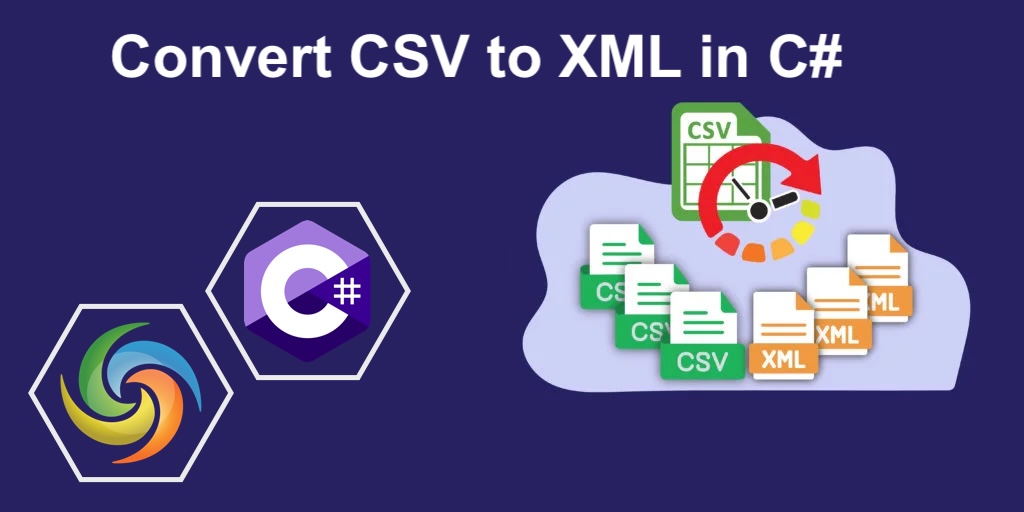The CSV (Comma-Separated Values) format is a lightweight tabular data structure widely used for data storage and exchange. However, when you need structured and hierarchical representation, the XML (Extensible Markup Language) format becomes a better choice, especially in enterprise data workflows, APIs, and legacy systems.
This article explains how to convert CSV to XML in C# .NET. You’ll learn how to upload a CSV file, call the API to export it as XML, and download the converted output.
- Why Convert CSV to XML in .NET?
- CSV and XML Processing API
- Export CSV to XML in C#
- Convert CSV to XML using cURL Command
- Try Free Online CSV to XML Converter
Why Convert CSV to XML in .NET?
While CSV is simple for flat data, XML offers greater flexibility and compatibility for systems that require hierarchical or metadata-rich structures. Automating CSV to XML conversion in .NET helps developers streamline data transformation and integration workflows across platforms.
CSV and XML Processing API
Aspose.Cells Cloud SDK for .NET enables developers to manipulate and convert Excel and CSV files into a variety of formats, including XML, [JSON][], and HTML. It operates entirely through REST APIs, ensuring no dependency on Microsoft Excel.
To install the SDK, use the following command:
Install-Package Aspose.Cells-Cloud
Then, register for a free Aspose Cloud account from the Aspose.Cloud Dashboard to obtain your Client ID and Client Secret for authentication.
Export CSV to XML in C#
Here’s a C# example demonstrating how to convert CSV to XML using Aspose.Cells Cloud SDK.
Step 1: Initialize the API:
var clientId = "YOUR_CLIENT_ID";
var clientSecret = "YOUR_CLIENT_SECRET";
var cellsApi = new CellsApi(clientId, clientSecret);
Step 2: Upload CSV File to Cloud Storage:
var fileName = "sample.csv";
using (var fileStream = System.IO.File.OpenRead(fileName))
{
var uploadResponse = cellsApi.UploadFile("input/" + fileName, fileStream);
}
Step 3: Convert CSV to XML Format:
var saveOptions = new SaveOptions { SaveFormat = "XML" };
var request = new PostWorkbookSaveAsRequest(
name: "sample.csv",
newfilename: "output/result.xml",
saveOptions: saveOptions,
isAutoFitRows: true,
isAutoFitColumns: true
);
var response = cellsApi.PostWorkbookSaveAs(request);

Preview of CSV to XML conversion using .NET Cloud SDK.
Convert CSV to XML using cURL Command
You can also perform the CSV to XML conversion using cURL commands directly from the terminal.
Step 1: Generate Access Token:
curl -v "https://api.aspose.cloud/connect/token" \
-X POST -d "grant_type=client_credentials&client_id=YOUR_CLIENT_ID&client_secret=YOUR_CLIENT_SECRET" \
-H "Content-Type: application/x-www-form-urlencoded" \
-H "Accept: application/json"
Step 2: Execute CSV to XML Conversion:
curl -v "https://api.aspose.cloud/v3.0/cells/{sourceFile}/SaveAs?newfilename={resultantFile}&isAutoFitRows=true&isAutoFitColumns=true&checkExcelRestriction=false" \
-X POST -H "accept: application/json" \
-H "authorization: Bearer {ACCESS_TOKEN}" \
-H "Content-Type: application/json" \
-d "{ \"SaveFormat\": \"XML\", \"ClearData\": true, \"CreateDirectory\": true, \"EnableHTTPCompression\": true, \"RefreshChartCache\": true, \"SortNames\": true, \"ValidateMergedAreas\": true}"
Try Free Online CSV to XML Converter
You can experience the conversion in action using our free CSV to XML Online Converter powered by Aspose.Cells Cloud.

Free online CSV to XML converter app powered by Aspose.Cells Cloud.
Useful Resources
Frequently Asked Questions (FAQs)
Q1: Can I convert multiple CSV files to XML automatically?
Yes. You can automate conversions for multiple files by iterating over them in your C# application and invoking the API for each file.
Q2: Does Aspose.Cells Cloud support formatting during CSV to XML conversion?
Yes, it maintains the data integrity and structure, ensuring properly formatted XML output.
Q3: Can I convert XML back to CSV using Aspose.Cells Cloud?
Absolutely. You can specify the save format as “CSV” when converting from XML to perform reverse conversion.
Q4: How fast is the CSV to XML conversion process?
It typically completes within seconds, depending on file size and internet connection.
Conclusion
Converting CSV files to XML format is simple with Aspose.Cells Cloud SDK for .NET. The API offers reliable, fast, and scalable conversion without the need for Excel. Whether you’re building automation tools or enterprise data workflows, this SDK ensures seamless and accurate CSV to XML conversion in the cloud.
Simplify your data exchange processes and get started today with a free trial account.
